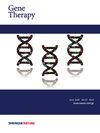AAV1.NT3 gene therapy mitigates the severity of autoimmune encephalomyelitis in the mouse model for multiple sclerosis
IF 4.5
3区 医学
Q1 BIOCHEMISTRY & MOLECULAR BIOLOGY
引用次数: 0
Abstract
Multiple sclerosis (MS) is an immune-mediated chronic inflammatory and neurodegenerative disease of the central nervous system (CNS) affecting more than 2.5 million patients worldwide. Chronic demyelination in the CNS has an important role in perpetuating axonal loss and increases difficulty in promoting remyelination. Therefore, regenerative, and neuroprotective strategies are essential to overcome this impediment to rescue axonal integrity and function. Neurotrophin 3 (NT-3) has immunomodulatory and anti-inflammatory properties, in addition to its well-recognized function in nervous system development, myelination, neuroprotection, and regeneration. For this study, scAAV1.tMCK.NT-3 was delivered to the gastrocnemius muscle of experimental autoimmune encephalomyelitis (EAE) mice, the chronic relapsing mouse model of MS, at 3 weeks post EAE induction. Measurable NT-3 levels were found in serum at 7-weeks post gene delivery. The treated cohort showed improved clinical scores and performed significantly better in rotarod, and grip strength tests compared to their untreated counterparts. Histopathologic studies showed improved remyelination and axon protection. These data correlated with reduced expression of the pro-inflammatory cytokines in brain and spinal cord, and increased percentage of regulatory T cells in the spleens and lymph nodes. Collectively, these findings demonstrate the translational potential of AAV-delivered NT-3 for chronic progressive MS.

AAV1。NT3基因治疗减轻多发性硬化症小鼠模型自身免疫性脑脊髓炎的严重程度。
多发性硬化症(MS)是一种免疫介导的中枢神经系统(CNS)慢性炎症和神经退行性疾病,影响全球250多万患者。慢性脱髓鞘在中枢神经系统具有重要的作用,在延续轴突损失和增加促进髓鞘再生的困难。因此,再生和神经保护策略对于克服这一障碍以恢复轴突的完整性和功能至关重要。神经营养因子3 (NT-3)除了在神经系统发育、髓鞘形成、神经保护和再生中具有公认的功能外,还具有免疫调节和抗炎特性。在本研究中,scav1 . tmck。NT-3在MS慢性复发性小鼠模型——实验性自身免疫性脑脊髓炎(EAE)小鼠的腓肠肌诱导后3周。基因递送后7周血清中检测到NT-3水平。与未治疗组相比,治疗组的临床评分有所提高,在旋转杆和握力测试中表现明显更好。组织病理学研究显示髓鞘再生和轴突保护得到改善。这些数据与脑和脊髓中促炎细胞因子表达减少以及脾脏和淋巴结中调节性T细胞百分比增加有关。总的来说,这些发现证明了aav递送NT-3治疗慢性进展性MS的转化潜力。
本文章由计算机程序翻译,如有差异,请以英文原文为准。
求助全文
约1分钟内获得全文
求助全文
来源期刊

Gene Therapy
医学-生化与分子生物学
CiteScore
9.70
自引率
2.00%
发文量
67
审稿时长
4-8 weeks
期刊介绍:
Gene Therapy covers both the research and clinical applications of novel therapeutic techniques based on a genetic component. Over the last few decades, significant advances in technologies ranging from identifying novel genetic targets that cause disease through to clinical studies, which show therapeutic benefit, have elevated this multidisciplinary field to the forefront of modern medicine.
 求助内容:
求助内容: 应助结果提醒方式:
应助结果提醒方式:


